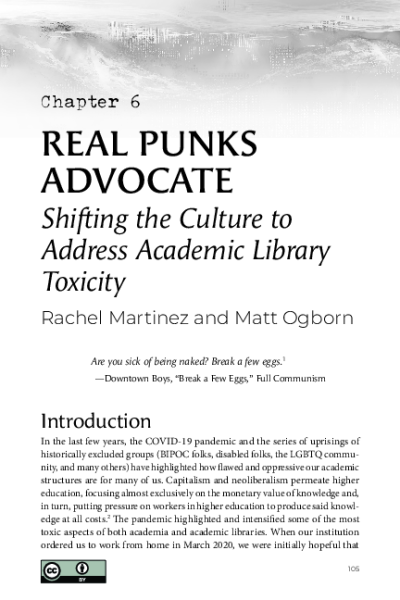Filtering by
- All Subjects: Academic libraries
- All Subjects: Education and state

The panel discusses and elucidate components of a student-to-student peer program and cover comprehensive planning aspects of personnel, communication and workflow methodologies, interdisciplinary representation, and competency building activities. They will share training and work protocols, focusing on the evolution of the program from conceptualization through implementation. The presentation is an interactive conversation between the panelists (covering varying aspects and perspectives of the program) and the audience.

Getting to the Core of Services: Considering the Arizona State University Library as a Core Facility

The Simon Ortiz and Labriola Center Lecture on Indigenous Land, Culture, and Community addresses topics and issues across disciplines in the arts, humanities, sciences, and politics. Underscoring Indigenous American experiences and perspectives, this Series seeks to create and celebrate knowledge that evolves from an Indigenous worldview that is inclusive and that is applicable to all walks of life.” Professor Simon Ortiz discussed the overall nature of the Series, especially emphasizing the global nature of Indigenous concerns. Joyce Martin and Matthew Harp elaborated on the contributions of the Labriola National American Indian Data Center and ASU Libraries to the Series.
The Labriola Center hosts an informal event in Hayden Library which facilitates close interaction between the featured speaker and audience members. The ASU Libraries records the evening lectures which take place at the Heard Museum and presents both an audio podcast and streaming video of each lecture on the ASU Library Channel webpage. This lecture series provides not only a chance for community discussion at the events themselves, but through the innovative use of technology the ASU Libraries enables additional forums for discussion in blogs and web pages which choose to link to the streaming videos.



The spread of academic testing for accountability purposes in multiple countries has obscured at least two historical purposes of academic testing: community ritual and management of the social structure. Testing for accountability is very different from the purpose of academic challenges one can identify in community “examinations” in 19th century North America, or exams’ controlling access to the civil service in Imperial China. Rather than testing for ritual or access to mobility, the modern uses of testing are much closer to the state-building project of a tax census, such as the Domesday Book of medieval Britain after the Norman Invasion, the social engineering projects described in James Scott's Seeing like a State (1998), or the “mapping the world” project that David Nye described in America as Second Creation (2004). This paper will explore both the instrumental and cultural differences among testing as ritual, testing as mobility control, and testing as state-building.

In the wake of both the end of court-ordered school desegregation and the growing popularity of accountability as a mechanism to maximize student achievement, the authors explore the association between racial segregation and the percentage of students passing high-stakes tests in Florida's schools. Results suggest that segregation matters in predicting school-level performance on the Florida Comprehensive Assessment Test after control for other known and purported predictors of standardized test performance. Also, these results suggest that neither recent efforts by the state of Florida to equalize the funding of education nor current efforts involving high-stakes testing will close the Black-White achievement gap without consideration of the racial distribution of students across schools.

Analysis of newly-released data from the Florida Department of Education suggests that commonly-used proxies for high school graduation are generally weak predictors of the new federal rate.

Chapter from the ACRL book Toxic Dynamics: Disrupting, Dismantling, and Transforming Academic Library Culture. This chapter provides a bit of background on punk and libraries, identifies some toxic library cultures, and then suggests concrete ways for library workers to disrupt these cultures while maintaining boundaries that are regularly violated in library work.

Videos are a useful and popular way to reach an audience — we all know videos that have gone viral online, garnering millions of views. However, the type of video that can compete with Old Spice commercials takes weeks to plan and produce, as well as a significant budget. Arizona State University (ASU) Libraries wanted to find a sustainable way to share videos that would require minimal staff time to create and produce.
With that goal in mind, “The Library Minute” was born. We initially envisioned a weekly newscast, but it has evolved into a successful and fun video series. Episodes have been featured in American Libraries Direct, as part of the ACRL Marketing Minute, received more than 74,000 views on YouTube and the Internet Archive, and have garnered complimentary e-mails from all over the world. Most importantly, they are a valuable marketing and outreach tool for the ASU Libraries and have increased our visibility to our students and other departments in the university.
